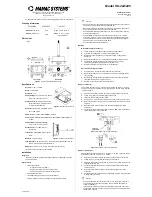
2/14/2007
Page - 17
How it works
Receiver
Signals from the antenna first travel through the transmitters low pass filter. It then passes through a T/R QSK
switch comprised of two, 2N7000 mosfets. During receive, Q9 is turned on and Q8 is turned off. This allows the
signal to pass into the link coupling into the front end tuned circuit. During transmit, Q9 is turned off and Q8 is
turned on, isolating the transmit signal from the receiver. Q7 is used as an inverter, as Q9 and Q* need
complementary logic signals.
The tuned input circuit is connected to a j-fet amplifier to isolate the mixer from the antenna and to provide some
gain. The 10 ohm resistor in the Source lead prevents VHF oscillations. The output of the amplifier is then coupled
into the mixer using a transformer wound on a small balun core. The mixer is an analog multiplexer. The analog
switches in the multiplexer connect the output load resistor across the secondary of the input tuned circuit at the
LO frequency rate. On each half cycle, the phase of the input signal across the load resistor is switched. This
produces the mixing of the LO signal and input signal, producing an audio beat note at the load resistor. Note that
there is no bias voltage on the analog switches. Biasing the switches to ½ the supply voltage would improve the
mixers' dynamic range, but was found not to be necessary. Any signal strong enough to overload the mixer with
out bias, would “blow your ears off”.
A high gain, differential input audio amplifier is connected to the mixers' load resistor. This stage provides most of
the gain for the receiver. A pair of back to back diodes across the amplifiers feedback resistor limits the peak to
peak output of the amplifier, to offer some hearing protection from strong signals. These diodes also reduce clicks
created by switching transits when switching from receive to transmit and back again.
The output of the first high gain audio stage is then routed though another analog switch, again without bias, for
audio muting during transmit. The signal then goes into an audio band pass filter stage. This filter has a Q of 8.
However, since only a single stage of filtering is provided, the filter isn't as narrow as a Q of 8 would imply when
strong signals are present. The output of this filter drives the headphones. A 10 ohm resistor helps keeping the
amplifier stable when driving the relatively low impedance of headphones and the .001 cap across the output helps
keep RF, which might be picked up by the headphone leads, out of the amplifier. The NJM4456 op amp used has
a high current output, so has no trouble driving headphones.
Oscillator and Transmitter
A classic Colpitts crystal oscillator provides the Local Oscillator. During receive, Q4 is turned on, which disables
any effect C34 has on the oscillator frequency. During transmit, Q4 is turned off, allowing C34 to increase the
oscillator frequency. C34 is used to set the transmit frequency about 600 Hz higher than the receive frequency,
providing proper T/R offset. When going from receive to transmit, the keyer chip will first mute the receiver and
shift the oscillator frequency before enabling the transmitter output. When going from transmit to receive, the
transmitter is first turned off, then after a delay of about 5 ms, the receiver is un-muted and the oscillator frequency
shifted.
Q3 buffers the LO output signal in order to drive the PA. This stage is turned on an off by the keyer chip, with the
help of Q5. R23 and R25, in combination with C35, form an R/C time constant which causes the output of Q3 to
ramp on and off in about 5 ms. This provides wave shaping to the output signal, as to eliminate key clicks.
The output of Q3 in turn drives the PA stage, a 2N7000 MOSFET. Diode D10 across the gate acts to double the
drive voltage by charging the coupling cap, C27 on negative cycles. This ensures there is enough drive voltage to
turn Q2 reasonably well on. The output of the PA, Q2 is coupled to the low pass filter through a bifilar wound
transformer. This provides some impedance matching and increase power output and efficiency. Capacitor C23
tunes the L3 coil to the second harmonic, which forms a trap. This ensures the spurious output of the transmitter is
well below required FCC limits. It also improves PA efficiency and power output.
A 78L05 regulator, U4, is used to supply the required voltage for the keyer chip and mixer. It also is used as a bias
voltage for the audio amplifier op-amp and supply voltage for the Q10 preamp and U2 mixer.
Содержание DC40A
Страница 18: ...2 14 2007 Page 18...


































